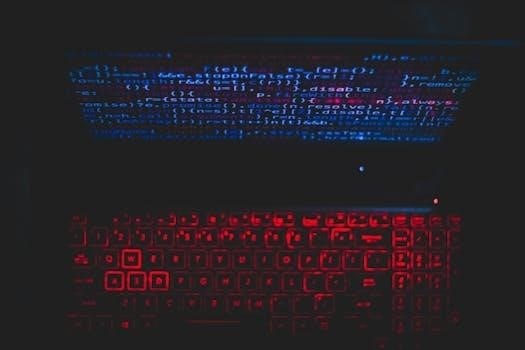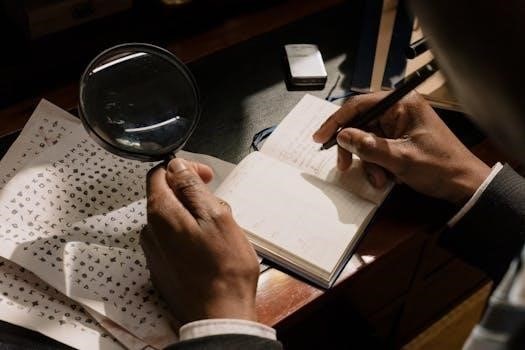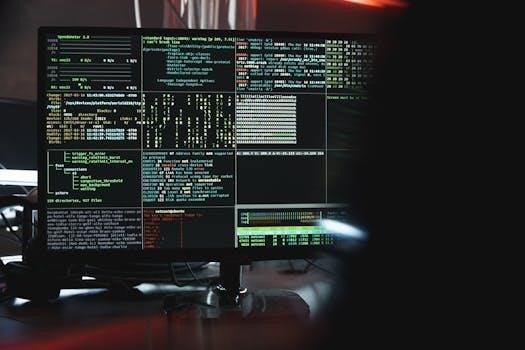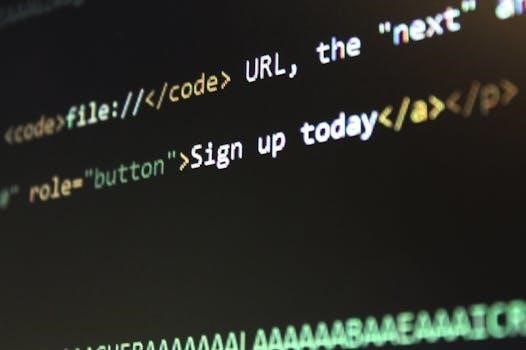The Da Vinci Code PDF⁚ An Overview
The Da Vinci Code is a captivating mystery-detective novel authored by Dan Brown. It intricately weaves a tale centered around Robert Langdon, a symbology expert. The novel thrusts Langdon into a world of ancient secrets, and hidden societies.
Dan Brown’s The Da Vinci Code is a thrilling journey into the realms of art, history, and secret societies. This mystery-detective novel introduces readers to a world where ancient symbols hold the key to profound revelations. The story commences with a murder within the Louvre Museum. This event propels Harvard symbologist Robert Langdon into a dangerous quest. Alongside Sophie Neveu, a gifted cryptologist, Langdon uncovers clues embedded in Da Vinci’s masterpieces.
Their investigation leads them to the Priory of Sion. It is a clandestine organization guarding a sacred secret about the lineage of Jesus Christ. As they delve deeper, they confront powerful adversaries. These adversaries are determined to protect the established order at any cost. The Da Vinci Code blends fact and fiction. It challenges conventional beliefs and sparks debate about religion, history, and the power of knowledge. The novel’s fast-paced narrative and intricate plot have captivated millions of readers worldwide.
Dan Brown and Robert Langdon
Dan Brown, the author of The Da Vinci Code, is renowned for his meticulously researched and suspenseful thrillers. Brown masterfully blends historical facts, conspiracy theories, and intricate puzzles. He creates narratives that grip readers from the first page. His writing style is characterized by short, punchy sentences. These sentences build suspense and propel the story forward at a relentless pace. Brown’s ability to weave complex plots and create compelling characters has made him a global literary phenomenon.
Robert Langdon, the protagonist of The Da Vinci Code, is a Harvard symbologist. He is thrust into a world of mystery and danger. Langdon is depicted as an intellectual and resourceful individual with a keen eye for detail. He is able to decipher ancient symbols and unravel complex codes. His expertise makes him the perfect protagonist to navigate the intricate web of secrets. He uncovers the secrets that lie at the heart of the novel’s central mystery. Langdon’s character embodies the pursuit of knowledge and truth.
Finding a free PDF download of The Da Vinci Code might seem easy. However, it’s crucial to consider the legal and ethical implications. Downloading copyrighted material without permission is illegal. It also deprives authors and publishers of their rightful compensation.
Free PDF Downloads⁚ Availability and Legality
The internet offers numerous avenues for acquiring digital content, including PDF versions of popular books like The Da Vinci Code. However, the availability of free PDF downloads often raises concerns about legality and ethical considerations. Copyright laws protect authors and publishers, granting them exclusive rights to distribute their work. Downloading a copyrighted PDF without authorization infringes upon these rights, potentially leading to legal repercussions for both the distributor and the downloader.
While some websites may offer free PDF downloads, it is essential to verify their legitimacy and adherence to copyright regulations. Opting for unauthorized downloads not only violates the law but also exposes users to potential risks such as malware, viruses, and compromised file integrity. Furthermore, it undermines the creative efforts of authors and publishers, hindering their ability to produce and distribute quality content. Supporting legitimate sources ensures that creators are fairly compensated for their work, fostering a sustainable ecosystem for literature and publishing.

Finding and Downloading the PDF
Where to Find a PDF Version of The Da Vinci Code
For readers seeking a digital copy of The Da Vinci Code, several legitimate avenues exist. Official online bookstores, such as Amazon Kindle Store, Google Play Books, and Apple Books, offer authorized PDF or ebook versions for purchase. These platforms ensure that you are acquiring a legal copy, supporting the author and publisher.
Another option is to explore digital libraries or subscription services like Scribd or OverDrive (often accessible through public libraries). These platforms provide access to a vast collection of ebooks, including The Da Vinci Code, for a monthly fee or through library membership. Always be cautious of websites offering free PDF downloads, as they may be illegal sources or contain malware. Verifying the legitimacy of the source is crucial to protect your device and respect copyright laws. If unsure, consider purchasing the ebook from a reputable retailer to ensure a safe and legal reading experience.

Content and Plot Summary
The Da Vinci Code follows Robert Langdon and Sophie Neveu as they unravel a murder mystery in the Louvre. Their investigation leads them on a thrilling quest involving religious secrets and historical conspiracies tied to Leonardo Da Vinci.
Robert Langdon and Sophie Neveu’s Investigation
Following a shocking murder at the Louvre Museum, Robert Langdon, a Harvard symbologist, finds himself unexpectedly entangled in a complex web of mysteries. The victim, Jacques Saunière, a curator, leaves behind a series of cryptic clues that only Langdon can decipher. He quickly joins forces with Sophie Neveu, a French cryptologist and Saunière’s granddaughter, to unravel the secrets.
Their investigation quickly reveals a hidden society and a series of historical conspiracies linked to Leonardo da Vinci’s artwork. As they follow the trail of clues, Langdon and Neveu realize they are not only solving a murder but also protecting a powerful secret that could shake the foundations of Christianity. Pursued by law enforcement and a shadowy organization, they must race against time. They seek to unlock the truth hidden within Da Vinci’s masterpieces. This leads them to discover the true nature of the Holy Grail.
Key Themes and Controversies
The Da Vinci Code delves into several controversial themes that sparked widespread debate upon its release. Central is the revisionist history surrounding the life of Jesus Christ and his supposed marriage to Mary Magdalene. The novel suggests that this lineage was deliberately suppressed by the early Church to maintain power. This challenges traditional Christian beliefs.
Another key theme is the power of secret societies, particularly the Priory of Sion. This organization is portrayed as the protector of the “true” story of Jesus. The novel explores the tension between faith and reason, questioning the historical accuracy of religious texts. The book ignited controversies. It faced criticism from religious figures. Historians disputed its claims. Despite the controversy, the book’s exploration of suppressed knowledge and alternative interpretations of history captivated readers. It raises questions about truth, power, and the stories we tell ourselves.

Related Materials
To deepen understanding of The Da Vinci Code, various resources exist. Study guides offer analyses of themes and characters. The film adaptation, starring Tom Hanks, provides a visual interpretation. These materials provide different ways to engage with the story.

Study Guides and Analyses
For readers keen on delving deeper into The Da Vinci Code, numerous study guides and analytical resources are available. These guides often provide detailed summaries of the plot, character analyses, and explorations of the novel’s central themes. They dissect the intricate symbolism and historical allusions woven throughout the narrative, shedding light on Dan Brown’s meticulous research and storytelling techniques.
Furthermore, study guides often address the controversies surrounding the book, particularly its interpretations of religious history and the role of secret societies. They offer diverse perspectives, encouraging critical thinking and a nuanced understanding of the complex issues raised by the novel. Some guides even provide supplementary materials, such as timelines, character maps, and glossaries of key terms, to enhance the reader’s comprehension.
Additionally, literary analyses explore the novel’s structure, narrative voice, and use of suspense. They examine how Brown masterfully blends fact and fiction to create a compelling and thought-provoking reading experience. These resources can be invaluable for students, book clubs, or anyone seeking a more in-depth appreciation of The Da Vinci Code.
The Da Vinci Code Film Adaptation
The Da Vinci Code‘s immense popularity led to a highly anticipated film adaptation, bringing Dan Brown’s intricate story to the big screen. Directed by Ron Howard and starring Tom Hanks as Robert Langdon, the movie aimed to capture the essence of the novel’s suspense, mystery, and historical intrigue. The film visually interpreted the book’s iconic scenes, from the Louvre Museum to the ancient mysteries of the Priory of Sion.
However, as with many book-to-film adaptations, the movie faced its own set of challenges and interpretations. While it strived to remain faithful to the core plot and characters, some details and nuances were inevitably altered or condensed to fit the cinematic format. The film also sparked discussions and debates regarding its portrayal of religious themes and historical accuracy, mirroring the controversies surrounding the novel itself.
Despite these discussions, the film adaptation introduced The Da Vinci Code to an even wider audience, further solidifying its place in popular culture. It provided a visual representation of the story’s complex puzzles and historical settings, enhancing the immersive experience for viewers. The film remains a significant part of The Da Vinci Code‘s legacy.
